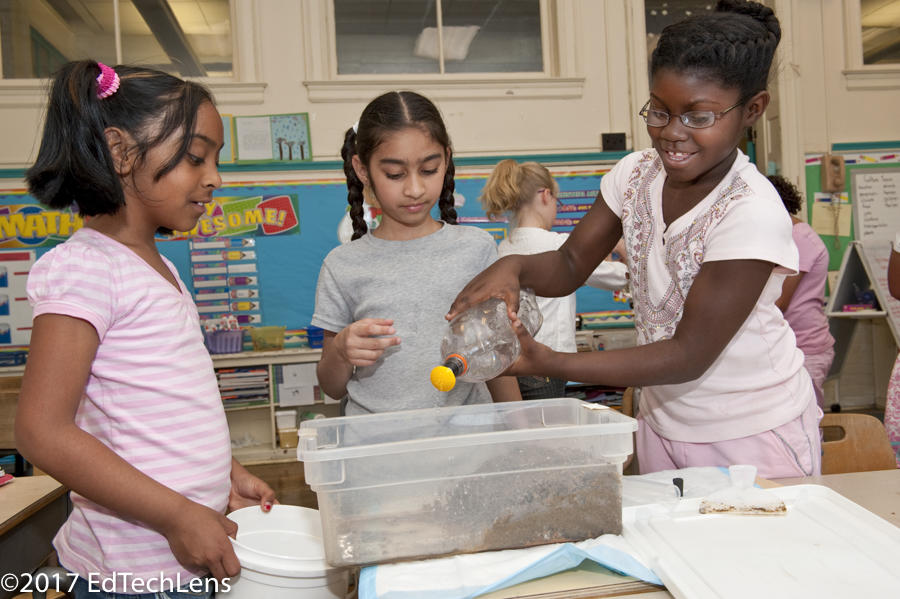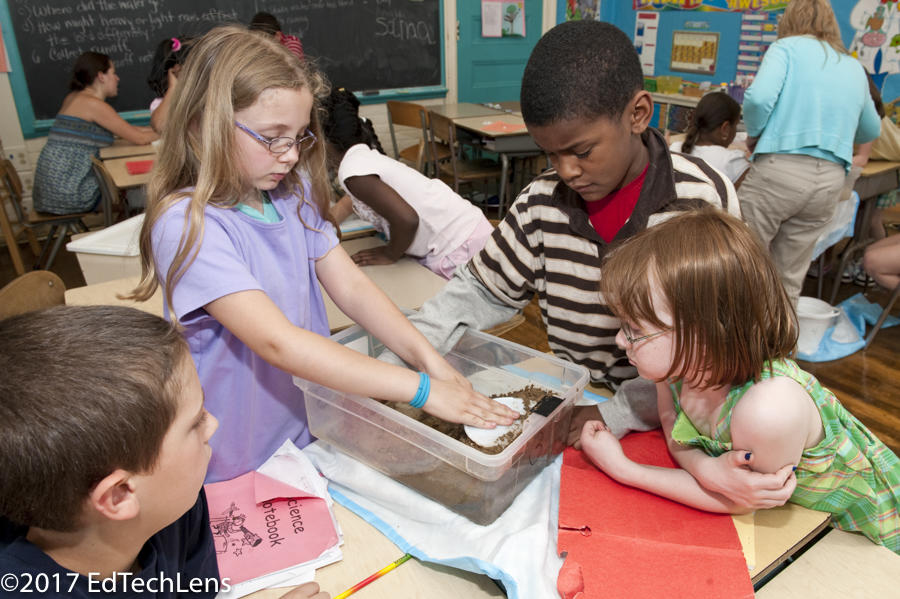
Developing Effective Thinking Strategies: Problem-Based Learning in the K-5 Life Science Classroom
“We only think when confronted with a problem,” said American philosopher and educator John Dewey. Most of us have experienced the motivating effect of a well-defined problem; problem-based learning (PBL) seeks to introduce K-5 students to the process of defining and solving messy, real-world problems. Research indicates that students learn more through PBL than through traditional educational approaches – lectures and test-taking – in part because they are more motivated.
“PBL gives teachers a way to inspire students to a deeper level of learning by making it relevant to their lives,” says Tom McConnell, associate professor of science education in the Department of Biology at Ball State University. What’s more, he says, is that “it helps students not only learn a concept, but also how the concept fits within the context of several different disciplines.”
“PBL gives teachers a way to inspire students to a deeper level of learning by making it relevant to their lives,” says Tom McConnell, associate professor of science education in the Department of Biology at Ball State University. What’s more, he says, is that “it helps students not only learn a concept, but also how the concept fits within the context of several different disciplines.”
Teaching Future Job Skills
With PBL, students are learning not just content, but thinking strategies as well. “Students learn to think in a flexible way,” McConnell says. That flexibility is likely to serve students well as they prepare to enter a future job market that’s hard for us to imagine today. “Even if it’s jobs that don’t exist yet, the way of thinking that’s represented in the PBL framework is flexible enough to be used in a variety of situations, not just math and science,” he explains.
And based on comments from the business consortiums McConnell works with, other soft skills PBL fosters, like the ability to work on teams and share information effectively, are in high demand today.
Bringing Problem-Based Learning Into the K-5 Classroom
Perhaps the biggest challenge in implementing PBL is developing a problem that strikes the right balance between providing enough information to start students on the road to exploration but not so much that they can solve it without finding additional resources themselves.
“A good problem represents science as it appears in the real world,” McConnell says. He started using PBL before he really knew what it was. “I was basing it on things that were happening in my community. I would encourage teachers to look for something locally relevant, something kids might hear about on the news or that might be happening in their own neighborhoods…something they already have questions about. Those kinds of issues or stories make great problems to base a lesson plan on.”
McConnell is co-author of Problem-Based Learning in the Life Science Classroom K-12 (see a 58-page excerpt from the book here), an in-depth guide to implementing PBL. The book explains that an ideal problem gives students a reason to collaborate to analyze the situation, ask questions, pose hypotheses, identify further information needed, and find that information by searching literature and making scientific investigations. A well-designed problem leads students through this process to jointly create a proposed solution.
What a Problem May Look Like
Problems are designed to promote flexible thinking by omitting some of the information necessary to solve the problem and by including some information that’s extraneous. “Students have to learn to ask themselves, ‘What’s the important information?’ and ‘What do we not have to think about so much?’” McConnell says.
Among the 150 pages of detailed life science problems in Problem-Based Learning in the Life Science Classroom is one called “The Purple Menace.” In the story, students learn that purple loosestrife lives in a marsh, has increased from one to 50 plants in 10 years, that there are cattails in the marsh as well, that the plants are found near boat access, etc.
Students read the story quietly as the teacher tapes three large pieces of paper to the board and labels them: “What do we know?” “What do we need to know?” and “Hypotheses.” After students have read independently, one student reads the story aloud. The teacher then facilitates a discussion that guides students toward generating information that populates the categories represented on the three pieces of paper.
Among the 150 pages of detailed life science problems in Problem-Based Learning in the Life Science Classroom is one called “The Purple Menace.” In the story, students learn that purple loosestrife lives in a marsh, has increased from one to 50 plants in 10 years, that there are cattails in the marsh as well, that the plants are found near boat access, etc.
Students read the story quietly as the teacher tapes three large pieces of paper to the board and labels them: “What do we know?” “What do we need to know?” and “Hypotheses.” After students have read independently, one student reads the story aloud. The teacher then facilitates a discussion that guides students toward generating information that populates the categories represented on the three pieces of paper.
Transitioning from Expert to Facilitator
McConnell and his co-authors (Joyce Parker and Janet Eberhardt) point out that in a productive PBL discussion the teacher avoids providing information that students can find on their own.
Instead of answering, “What’s purple loosestrife?” a facilitator points out that it’s a good question to add to the “What do we need to know?” sheet and asks the group if anyone knows what it is. A student asks if she can look it up.
Compare this with the teacher-as-expert role, where the teacher provides the answer, that “purple loosestrife is a plant found in wetlands across the Midwest. It grows about 6 feet tall, and spreads quickly when it gets in the marsh.”
The expert answer to the student’s question minimizes student inquiry and in this case has also fed the group a key bit of information – it spreads quickly in a marsh – that is necessary to solving the problem and which would have been a productive student discovery. (On page 24 of the Problem-Based Learning in the Life Science Classroom excerpt, you can see a table that further illustrates the difference between teacher-as-expert and teacher-as-facilitator )
McConnell warns against the misperception that PBL is hard to integrate because it’s time consuming, especially for teachers required to follow a rigid curriculum map. He points out that more than one concept can be covered within one problem, which alleviates the pressure of adhering to a curriculum. “Math is a natural part of analyzing or processing data and coming up with possible solutions,” he says, “and social studies emerges really quickly in the process of developing solutions as well. Students get practice with online research and must use their writing and reading skills throughout the process.”
Learning That’s Connected to the Real World
Getting their hands dirty with a real-world problem allows students to learn from direct experience rather than direct instruction. McConnell says, “Our research shows students retain the concept longer. With problem-based learning, concepts become a more robust piece of learning than just a rote memory.”
About Tom McConnell: Tom J. McConnell is an associate professor of science education in the Department of Biology at Ball State University, Muncie, Indiana. He teaches science teaching methods courses for elementary and secondary education majors and graduate students, as well as a biology content course for elementary teachers. His research focuses on the influence of professional development on teacher learning and student achievement, and it focuses on curriculum development for teacher education programs. He is also an active member of the Hoosier Association of Science Teachers and the National Association of Research in Science Teaching.


